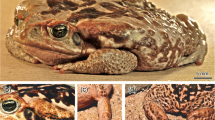Abstract
The ormer, Haliotis tuberculata Linnaeus, 1758, is able to accumulate paralytic shellfish toxins (PST) in the foot side skin. Epidermal and secretory cells are described separately for the pedal side and sole epithelia, as notable differences have been observed. Melanin and photosynthetic pigment granules in the epidermal cells of the foot side epithelium give this skin its appearance and characteristic color. This epidermis also has abundant secretory cells containing at least three kinds of secretory granules. Conversely, the epidermal cells of foot sole epithelium do not have pigment granules, and the secretory cells are mostly subepithelial. Immunohistochemical reaction against PST (saxitoxin and its derivatives) showed that the toxins are located in specific cells of the foot side epithelium, which are distinct from the epidermal cells. Immunofluorescence also reveals toxins throughout many areas of the mucilage covering the epithelium, suggesting the secretory nature of the cells containing the toxins. These results do not show any apparent relationship between melanin or photosynthetic pigment granules and PST content. PST were not detected in the foot sole epithelium either immunohistochemically or by HPLC. Considering the toxic characteristics of ormers described in previous studies and the results presented here, the authors discuss the role of toxins retained or produced by the foot side epithelium
Similar content being viewed by others
Author information
Authors and Affiliations
Additional information
Received: 25 July 2000 / Accepted: 7 November 2000
Rights and permissions
About this article
Cite this article
Bravo, I., Franco, J., Alonso, A. et al. Cytological study and immunohistochemical location of PSP toxins in foot skin of the ormer, Haliotis tuberculata, from the Galician coast (NW Spain). Marine Biology 138, 709–715 (2001). https://doi.org/10.1007/s002270000497
Issue Date:
DOI: https://doi.org/10.1007/s002270000497




